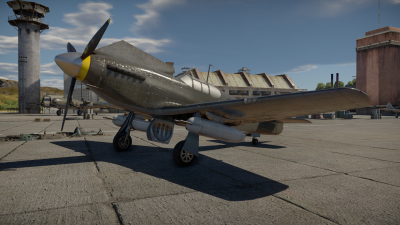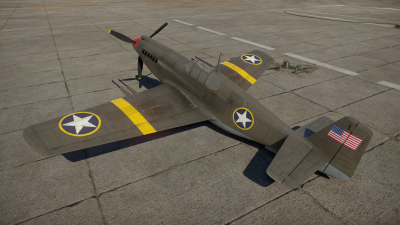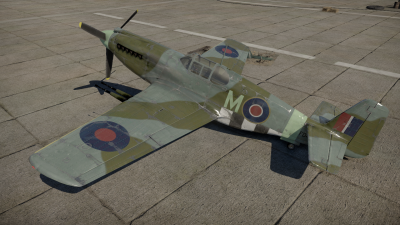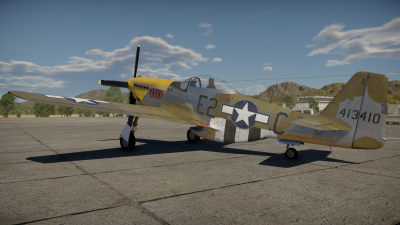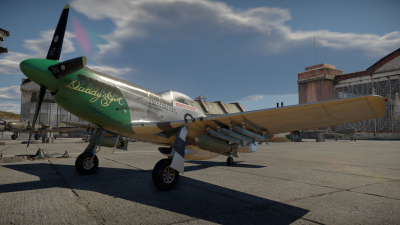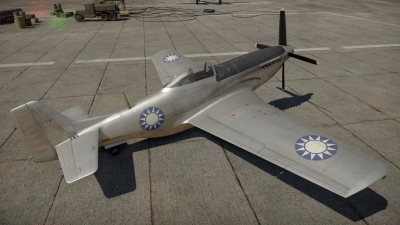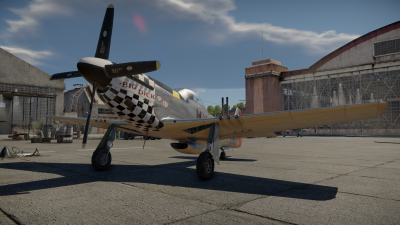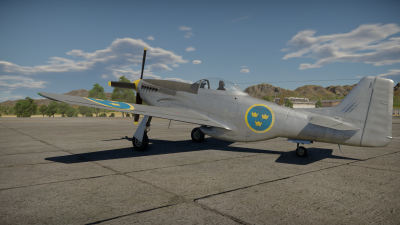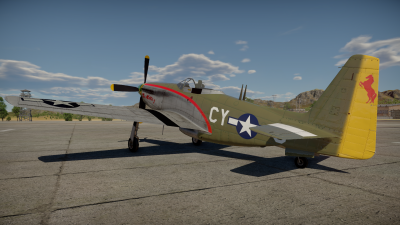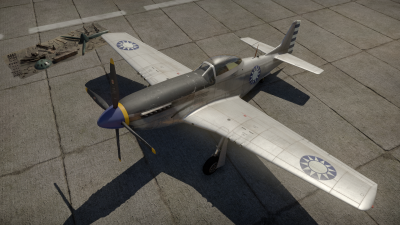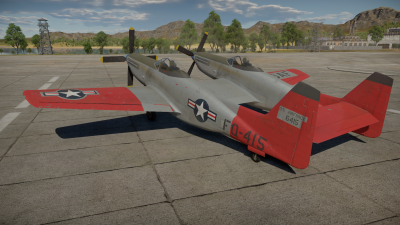P-51 (Family)
P-51 may refer to:
Contents
History of family.
World events.
Germany had built up enormous production capabilities and was churning out aircraft using the latest technology. Britain and France quickly realized they well behind manufacturing capacity of Germany and looked to American manufacturing to catch up.
The proposal.
Britain wanted the Curtiss P-40 fighter but they were at production capacity so instead asked North American Aviation (then known for the B-25 "Mitchell" bomber and AT-6 "Harvard" trainer also purchased for the RAF) about making the P-40. NAA President James Howard "Dutch" Kindelberger proposed he could design a new, better fighter in less time than get a licenses for the P-40.
Birth of a legend.
In just 102 after the agreement the NA-73X rolled out of the factory, flying 47 days later, and incredibly short time. 2 key differences on the NA-73X compared to contemporary fighters was moving oil and water radiators to the rear of the aircraft with extensive duct work, and a new “laminar flow” wing airfoils. The NAA/NACA 45–100 airfoils was a brand new invention that promised significantly reduced turbulence, thus drag, at high speed. Kindelberger gambled the company this new airfoil would deliver the performance desired, since the airfoil data was mostly theoretical. Much to relief of NAA the finished aircraft performed well and orders were put in (one of the prototype NA-73X provided to the USAAC (XF-51) exist today! BuNos 41-038, NX51NA).
Polishing the Diamond.
Pleased with the new fighter, on 24 April 1940 the British commission purchased 320 NA-73s, plus 300 updated units labeled NA-83s, all of which were designated “North American Mustang Mark I” by the RAF. Although the purchase was before the Blitzkrieg and Battle of Britain, it was not until October 1941 when they were delivered in UK with the first Mustang Mk Is entering service in January 1942. Unfortunately the installed Alison V-1710 engine of the Mark I’s had poor high altitude performance, so missions were relegated to low altitude recon and ground attacks, which was actually a poor mission type for the laminar flow wing! Despite this the Mustang was seen as winning design by pilots and engineers so effort was made to improve it. In April 1942 Rolls-Royce was invited to test the Mk 1, it did not take long to see its potential with the much better Merlin 61 installed. Fitting the engine was not difficult, but an extra chin radiator was needed because existing radiator was insufficient for the more powerful and hotter engine. While it looked funny, the performance was anything but, exceeding expectations and leaving the legendary Spitfire in the rear view. The Mk X proved the hypothesis and the push was on to put a British engine in a fighter built and paid for the British.
British have a Mustang fan club.
Meanwhile across the Atlantic the USAAC was not that enthusiastic about their recent addition, the newly designated P-51. The generals stubbornly believed a heavily armed bomber was better, and if they did need escorts then the P-38 and P-47 were a better choice. After Pearl Harbor more resources went to naval aircraft and bombers. When the first USAAF bombing missions from England against Nazi German started it did not take long to realize they had to change bombing tactics. The British were more than eager to show the Americans the new fighter and pushed for the US company Packard to build the Merlin (Packard V-1650-3 Merlin). By early 1943 the Merlin powered P-51B / Mustang Mk III was rolling off the assembly line and into history.
A most British of aircraft.
One can write books on the exploits of the P-51 but for here will just hit the high points. While most well known for missions in Europe, they were also critical in escorting B-29’s over Japan. After the war P-51 was retained while all the other land based piston fighters were decommissioned. They were critical in the Korean War, once again being heavily used for ground attack as jets now ruled the skies. Mustangs do not account for any unique combat record, but that does not diminish its incredible impact on combat operations, including the first engagements against jet fighters over Germany. All this happened because of the British not only funded its design and provided a superior engine, but also enthusiastically encouraged the USAAF to develop and use it.
Legacy
P-51s were sold to dozens of countries military for years after, and to individuals as private aircraft. They became popular racing aircraft and are a staple at air shows all over the world. Today over 150 airworthy P-51’s fly, and hundreds more found in museums adding to the legend and mythos. A footnote, when Ford Motors introduced a sporty new car the name Mustang was selected not for the horse but after the P-51; it too is a legendary vehicle.
The Mustangs!
A-36 P-51
- P-51 variants P-51 (no suffix), A, and Mustang Mk I and II were the original Allison engined versions. These aircraft were originally named "Invader" by the USAAF, but soon changed to "Mustang" for consistency with the RAF version.
- A-36 was the ground-attack version of the P-51A. It featured dive brakes on the upper and lower surfaces of the wings. Its official name was "Apache", but was often referred to as "Invader" or "Mustang".
- P-51B, C, and Mustang Mk III featured a license-built British Merlin engine. The B and C models were identical, the only difference being the place of manufacture. The aircraft were originally designated P-78.
- P-51D, K, and Mustang Mk IV were the definitive bubbletop variants. The D and K differed only in the use of propeller.
- XP-51F, G, J and P-51H, L, and M were lightweight versions. Most were powered by Merlin engines, but the J was powered by an Allison. Only the H was mass produced, but was too late to see combat in WWII. The L and M were canceled after the war with only a single M produced.
- P-51s modified for photo-reconnaissance were redesignated F-6.
- P-51s still in service in 1947 were redesignated F-51s. This change was due to the Air Force breaking off from the Army.
- Some F-51Ds were modified as two-seat trainers. These are known as TF-51Ds.
- Commonwealth Aircraft Corporation in Australia produced P-51Ds locally as the CA-18 Mustang Mk 21, Mk 22, and Mk 23. The first such aircraft were assembled from kits supplied by the US under the designation CA-17 Mustang Mk 20. CAC also planned to produce the P-51H locally as the CA-21 Mustang Mk 24, but orders were cancelled after the war before any were built.
- After the war, Trans Florida Aviation (later Cavalier Aircraft Corporation) bought surplus P-51s and modified them into executive business aircraft. These were known as Cavalier Mustangs, many of which survive today but have been restored back into P-51s (most as TF-51s).
- Cavalier Aircraft Corporation also rebuilt P-51D airframes with upgraded military equipment for export to El Salvador and Indonesia under the designation Cavalier Mustang II.
- XP-82, P-82B, C, and D were basically two P-51Hs joined at the wing and counter-rotating propellers. The P-82 (later F-82) was known as the "Twin Mustang".
- XP-82A, F-82E, F, G, and H were powered by Allison engines as the Merlin was no longer produced in the US.
- PA-48 "Enforcer" was a heavily modified Cavalier Mustang with a turboprop engine. It was originally designated Cavalier Turbo Mustang III before it was sold to Piper Aircraft. It failed to receive a USAF contract, and only four aircraft were produced, ending Mustang production.


